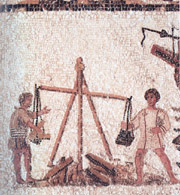
THE SLAVERY
The whole style and quality of life in Ancient Rome was degraded by its dependence upon slave labour. It was the common practice in all Mediterranean lands to use human beings as though they were animals or tools, but no people in recorded history owned so many slaves or relied as heavily upon slave labour as the Romans.
Before the third century b.c. none but the very rich had large numbers of slaves. A small scale Roman farmer managed his holding of two to five acres (0,8 to 2 hectares) helped by his family or with one or two slaves. They would probably also have been natives of Italy, folk very like himself and his wife. They helped on the farm and in the house, living as one of the family. The links in Rome between the slaves and members of the family might indeed be even closer, for many were brought into the family life and worship and shared in its religious celebrations, particularly the Saturnalia, the ancient mid December feast. No people who had such ceremonies could have entirely forgotten the common humanity which united themselves and their slaves.
So long as Rome increased its territory and power at the expense of neighbouring Italian peoples, the majority of the slaves were Italian. But in the second and first centuries b.c. the first striking change in traditional practice occurred, when hordes of foreign slaves began to pour into Rome as a result of many campaigns by Roman armies in Spain, Greece, Macedonia, Asia Minor, and later under Julius Caesar in Gaul and Britain. The island of Delos became a wholesale market for slaves from Asia: in one day thousands of slaves might change hands there, to be shipped like cattle to Rome where they were exhibited, men, women and children, naked in the slave markets, and sold one after the other to the highest bidder. If they had just been brought to Rome their feet were whitened with chalk and a placard was hung round their necks advertising their qualities and defects, for the market inspectors, the aediles, would hold the seller responsible for any false statement about their merchandise, human or otherwise. The choicest slaves were probably disposed of privately to rich customers.
Capture by war was the main source of slaves during the Republic and early Empire and it was often one motive for war. In early times army commanders were proud to bring back such handsome dividends to the public Treasury. During the last century of the Republic, this ancient honesty was set aside. Sulla, Pompey and Caesar became immensely rich after their successful campaigns by regarding much of what their troops had looted, particularly the slaves, as their own private property. Many slaves were also secured by piracy, by kidnapping even on the streets of Rome, as well as on the highways. The children
of mothers who were slaves, became slaves in their turn, property of whoever owned the mother. As foreign conquests ceased during the later Empire, the children of slaves became a main source of supply. Some free-born children cast out by their parents might be taken up by others and reared as slaves, although it was illegal to make slaves out of the children of free-born Romans. Once enslaved, however, it would have been very difficult to rescue them. There was a vast increase in the number of slaves in the Roman cities and towns (Pompeii included) after the second century b. C. . Vast numbers were sent to labour under harsh treatments in the country. It seems like that throughout the last five centuries of Roman history there would have been about five to seven million people in Italy, of whom about two million were slaves. There were also about a quarter of a million free foreigners. Slaves, of course, were not shared among all families equally, but anyone, even another slave, could buy them.






